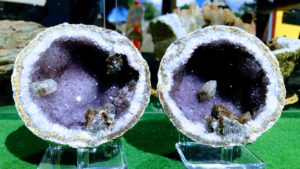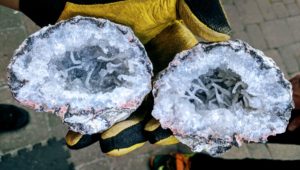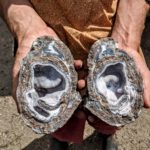Geodes FAQ
These particular Geodes are known as “Coconut Geodes” and are found in Chihuahua, Mexico inside Mines that are up to 200 feet deep!
You may have noticed that these Geodes are incredibly round and almost look man made. And the reason for this is because all of these "Geodes" were once gas bubbles inside scorching hot Lava! And once the Lava finally cooled off it began to harden, which trapped the Gas bubbles inside the Lava for eternity. So eventually over time ground water gets washed through the pocket that was created by the gas bubble and leaves a layer of Silica Gel mixed with different types of Minerals. Then over hundreds of thousands of years the Silica gel will eventually harden into what is known as Chalcedony (Agate Base) and Quartz (Crystals). And depending on what type of minerals were in the silica gel, that will determine what color the crystals are!
The Coconut Geodes are believed to be from the Cenozoic Era in the Tertiary Period making them anywhere from 35 to 65 million years old!
Having cracked thousands upon thousands of Coconut Geodes I can say with confidence that there really is no foolproof way of telling exactly what color and formations are going to be inside of a Geode. However, there are two things you can deduct by examining the outside of the Geode. First, if you feel through many Geodes and find one that seems to be very light relative to all the other Geodes the same size, you can assume that it is probably going to be quite hollow on the inside. Thus yielding a larger pocket. Secondly, you will sometimes notice a bit of Agate showing through the outside of the Geode. If you see this you can reasonably expect that you might have some Agate on the inside of the Geode.
The color of the quartz is due to what is called a color center. A color center is created when an electron becomes trapped in a vacancy in a crystal’s structure and vibrates at a certain frequency dictated by the size of and type of “hole” or vacancy where it is trapped. The vibrating electron inside the hole will absorb certain frequencies from white light and the remaining frequencies that are not absorbed are the color that we see. These “holes” open up when a few atoms of some impurity (an element that is not part of that minerals essential structure) become incorporated into what is called the crystal lattice. Radiation provides the energy necessary to knock an electron off an atom and send it careening about until it gets trapped in one of these holes in a manner similar to the way a well executed pool break will send several pool balls into the pockets of the table. And as long as that electron stays vibrating in it’s hole, it will produce color. If, however, the crystal is warmed too much, the electron can pick up that heat and use the energy to jump out of its hole – thus ending it’s color streak.
Smoky Quartz– The color in Smokey Quartz is a relatively “shallow” hole. As a result of these shallow color centers, the color in Smokey Quartz is not very stable and can fade when exposed to even modest heat.
The impurity atom that creates Smokey Quartz is Aluminum. It takes an incredibly small amount of Aluminum to create the smoky color. Somewhere in the range of .002 percent by weight.
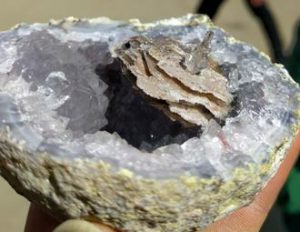
Amethyst– Similar to Smoky Quartz Amethyst (Purple Quartz) is due to a color center. However, the impurity atom found in Amethyst is Iron. Which upon being irradiated creates the beautiful purple color that everybody desires.
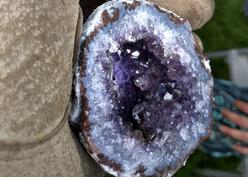
The Coconut Geodes are well known for their secondary crystals which are known as Calcites. These Calcites are secondary minerals that entered the pocket after the base layer had already formed and crystallized on top. A full list of these secondary crystals can be found below.
These particular Geodes are known as “Tranca Geodes” and are found in Chihuahua, Mexico about 100 miles South of the Choya mine in an area known as “The Tranca Ranch.”
You may have noticed that these Geodes are incredibly round and almost look man made. And the reason for this is because all of these Geodes were once gas bubbles inside scorching hot Lava! And once the Lava finally cooled off it began to harden, which trapped the Gas bubbles inside the Lava for eternity. So eventually over time ground water gets washed through the pocket that was created by the gas bubble and leaves a layer of Silica Gel mixed with different types of Minerals. Then over hundreds of thousands of years the Silica gel will eventually harden into what is known as Chalcedony (Agate Base) and Quartz (Crystals). And depending on what type of minerals were in the silica gel, that will determine what color the crystals are!
The Tranca Geodes are believed to be from the Cenozoic Era in the Tertiary Period making them anywhere from 35 to 65 million years old!
Having cracked thousands upon thousands of Coconut and Tranca Geodes I can say with confidence that there really is no foolproof way of telling exactly what color and formations are going to be inside of a Geode. However, there are two things you can deduct by examining the outside of the Geode. First, if you feel through many Geodes and find one that seems to be very light relative to all the other Geodes the same size, you can assume that it is probably going to be quite hollow on the inside. Thus yielding a larger pocket. Secondly, you will sometimes notice a bit of Agate showing through the outside of the Geode. If you see this you can reasonably expect that you might have some Agate on the inside of the Geode.
Most Tranca geodes have either clear or white crystals on the inside due to the lack of impurities (other minerals) present in the ground when the silica gels were being washed through the gas bubble. See examples of different types of Trancas geodes on the Geode Gallery page.
Unique to the Trancas geodes, these crazy finger like crystals are called “Scepter Quartz.”
Dugway geodes are found in a 1.5 square mile bed in the desert of Juab County, Utah.
Dugway geodes, like many other geodes, are formed as the result of volcanic activity. These particular geodes began as hollow Lithophysae (Rock bubbles) within molten Rhyolite rock when it surfaced and began to flow above ground. As the molten Rhyolite began to cool, Cristobalite and Perthite from within, crystallized into ball shaped “Spherulites.” Occasionally some of these spherulites, upon reaching maturity, expel a flash of hot gas creating a star-shaped bubble. This reaction is responsible for the unique star-shaped pockets found in some Dugway geodes. Later on ground water washes through the interior pockets of these spherulites leaving behind silica gels that eventually harden into your layers of agate and eventually quartz crystals (once the water dissipates). In some instances if the pressure is too great on the spherulite the gas flash might be too weak to open up a pocket within the spherulite resulting in it becoming a nodule instead of a geode (totally solid).
The Dugway Geodes are believed to have been formed from a volcanic event between 6-8 million years ago which would mean they were formed during the Miocene Epoch.
Dugway geodes range from 1-12 inches in diameter.
From outside to inside the Dugway geodes are comprised of:
- Rhyolite (exterior shell)
- Agate (Solid blue band between Rhyolite and crystals)
- Quartz (can range in color from blue, to white, to red, and many more).
